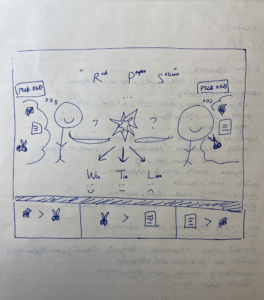1. Identify the basic elements in a game of your choice (actions, goals, rules, objects, playspace, players).
I’m taking a look at Pokemon GO, which I played aggressively when it was at its peak and through most of the quarantine period. At the time, it was a great way for me to explore my undergrad campus and (during quarantine) bond with my mom. I don’t play frequently anymore, so I’m not as familiar with any major changes; I’ll be addressing the version I played.
- Actions
- Walk around IRL!
- Catch Pokemon
- Spin PokeStops
- Engage in gym battles
- Engage in raids
- Goals
- Level up trainer
- Level up Pokemon
- Catch new and better Pokemon
- Catch rare Pokemon (e.g. Legendaries, Shinies)
- Hatch eggs
- Take over gyms
- Complete missions / research tasks
- Rules
- Explore the world around you
- Don’t trespass!
- Objects (non-exhaustive)
- Poke Balls
- Candies (for evolution)
- Berries
- Incense
- Raid Passes
- Playspace
- AR (augmented reality); real world + digital game
- Players
- Only one needed, but can involve any amount of people via gym battles, raids, Community Days
2. As a thought experiment, swap one element between two games: a single rule, one action, the goal, or the playspace. For example, what if you applied the playspace of chess to basketball? Imagine how the play experience would change based on this swap.
What happens if we apply the action of Tag to Ping Pong? In this case, I imagine that players must ‘hit’ the ball to their opponent by ‘tagging’ or hitting it with their actual hand. Consequently (and strangely), Ping Pong becomes an intensely tactile game, removed from the essential element of the paddle. Players will need to change their technique — such as the strength they employ and perhaps the angle they approach the ball from — in order to hit the ball back. They might also need to consider how much and/or which parts of their hand to use — a finger? Multiple fingers? The palm or back? And so on. I think this would be pretty interesting to watch.
3. Pick a simple game you played as a child. Try to map out its space of possibility, taking into account the goals, actions, objects, rules, and playspace as the parameters inside of which you played the game. The map might be a visual flowchart or a drawing trying to show the space of possibility on a single screen or a moment in the game.
Let’s take a look at Rock Paper Scissors:

4. Pick a real-time game and a turn-based game. Observe people playing each. Make a log of all the game states for each game. After you have created the game state logs, review them to see how they show the game’s space of possibility and how the basic elements interact.
Real-time game: Jeopardy!
| Game State | Comments / Elements |
| Opening |
|
Regular Jeopardy
|
|
Double Jeopardy
|
|
Final Jeopardy
|
|
| Closing |
|
Turn-based game = Chess
| Game State | Comments / Elements |
| Opening |
|
Gametime
|
|
| Closing |
|
I found it challenging to create both of these game state logs. Though both games have clearly defined elements, they interact in a range of ways that seems hard to log precisely, regardless of whether they are real-time or turn-based. Though there certainly seem to be main sequences or states (for instance, in Jeopardy!, the current standings of the players is explicit), this doesn’t capture other elements such as players’ reaction times or whether they chance upon the Daily Double. In the case of chess, an expert player may be able to assess the status of the game quickly, but for a novice like myself, it’s hard to see exactly what’s going on aside from obvious maneuvers and elimination of pieces (I remember watching Queen’s Gambit — I’m thinking of how players knew several moves ahead of time that they would lose, or that the game would end in a draw, when it just looked like a board to me). Or I just need to play more chess!

